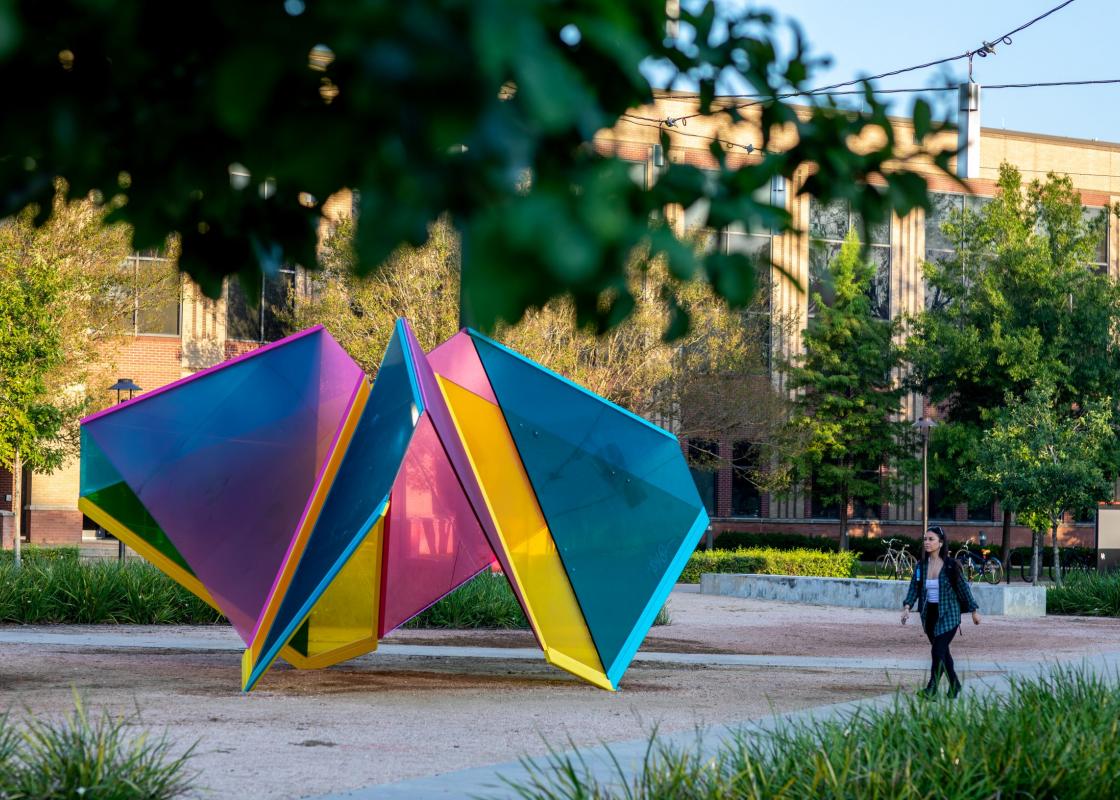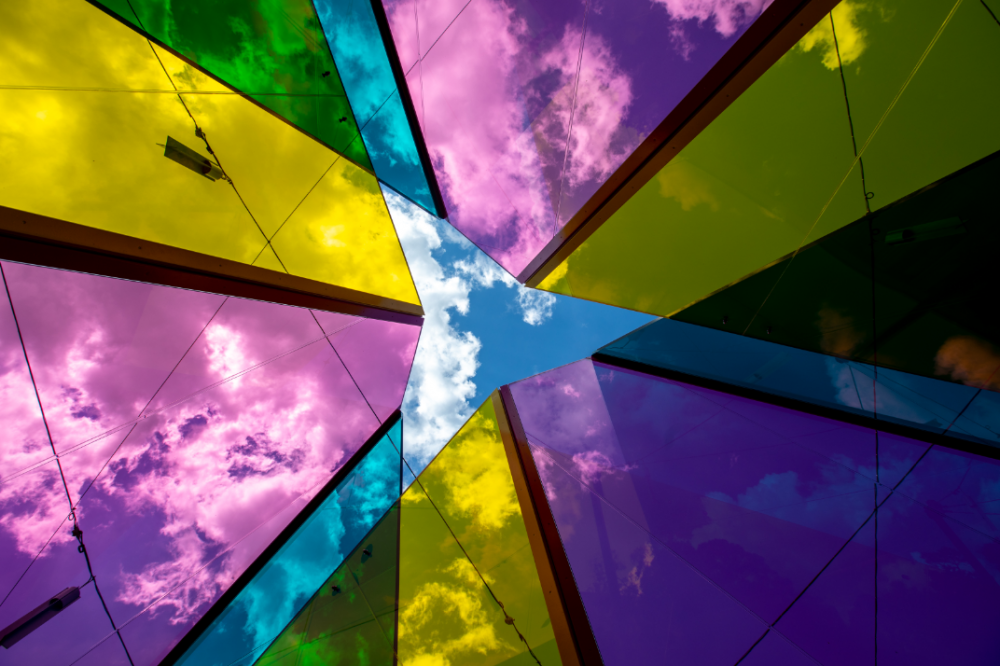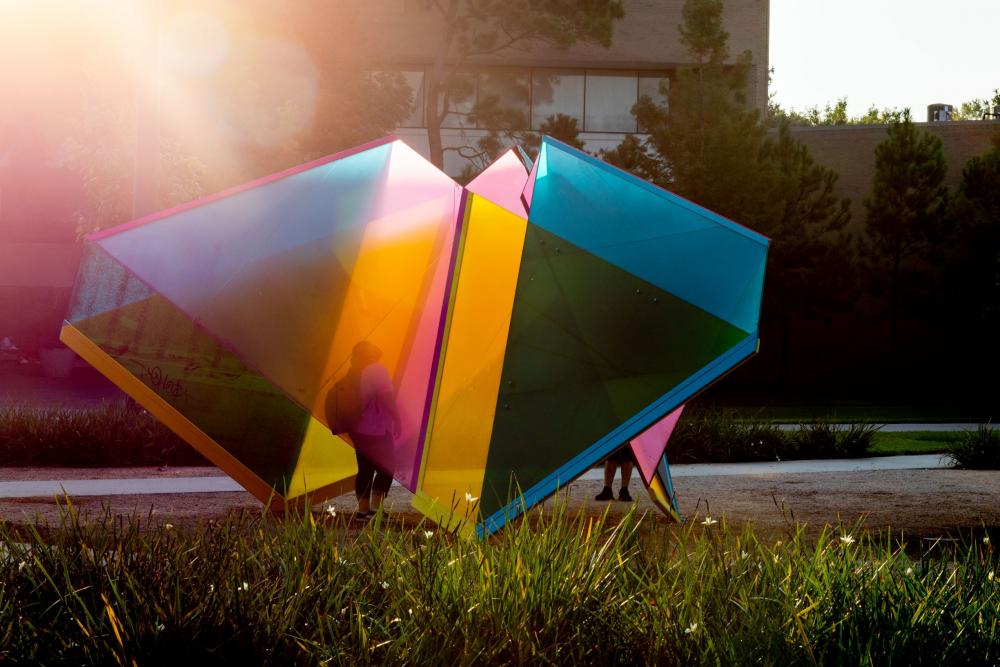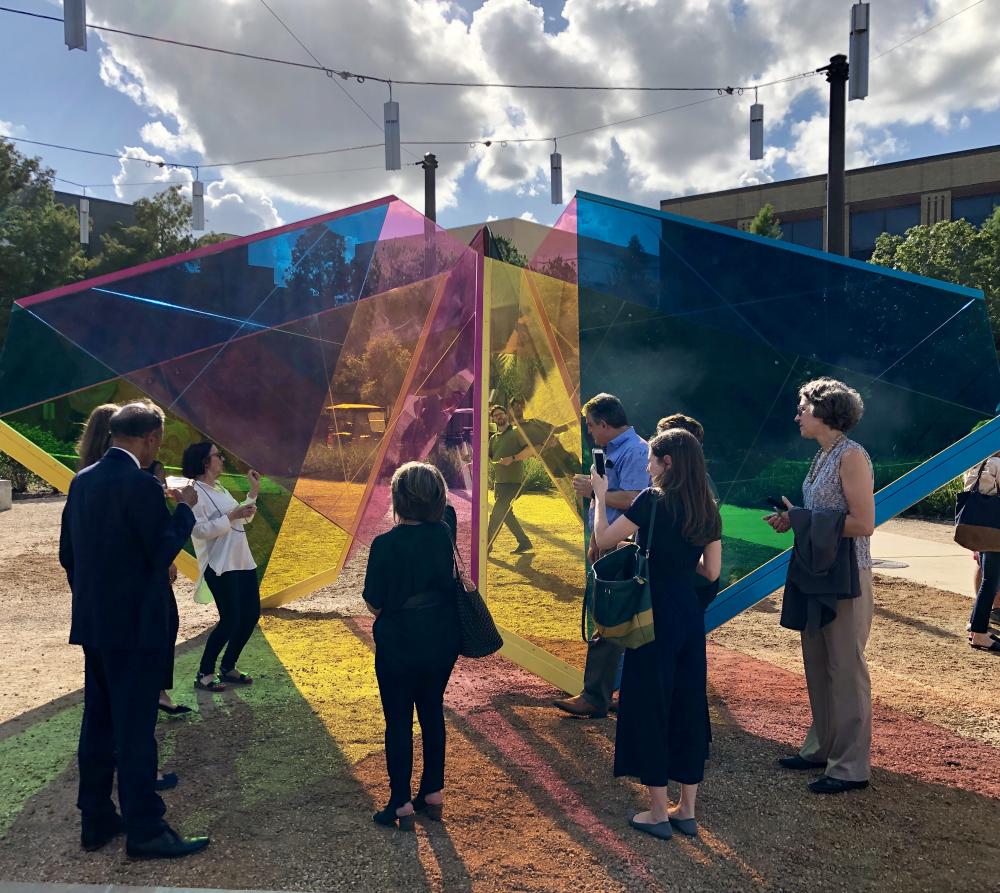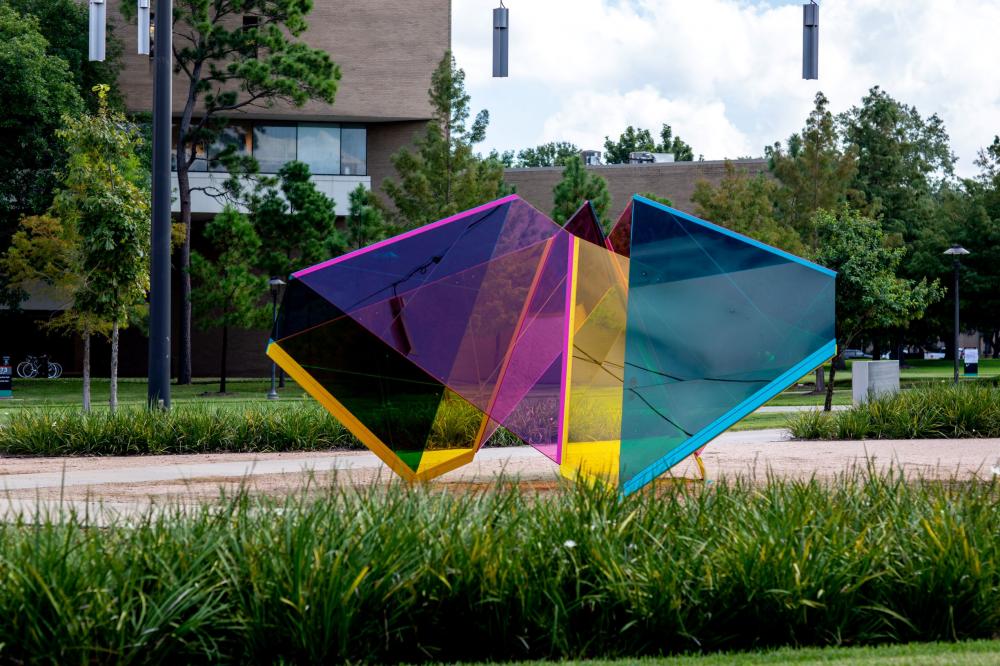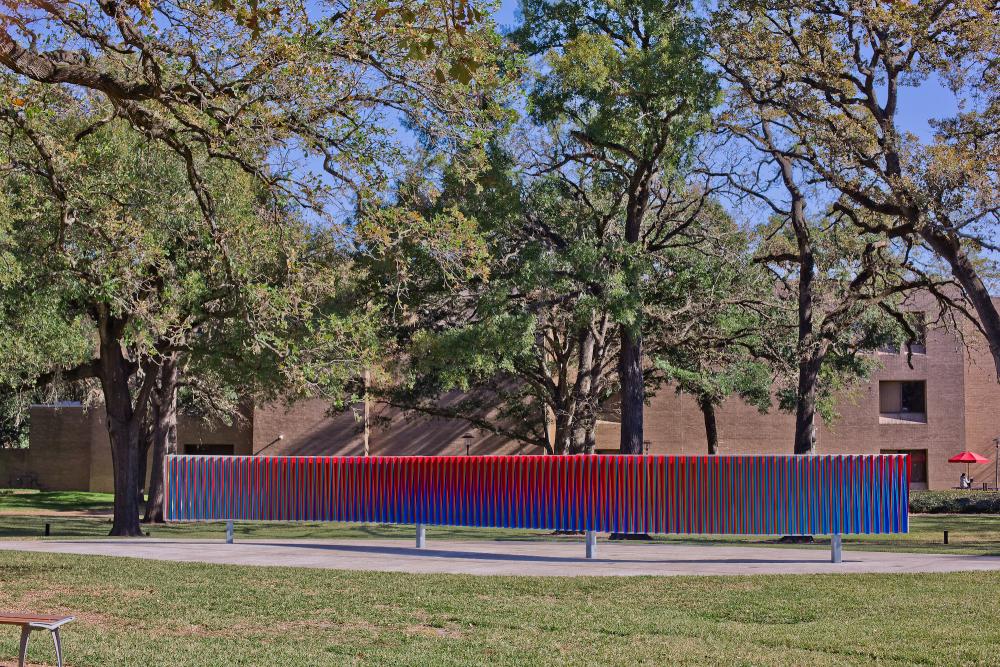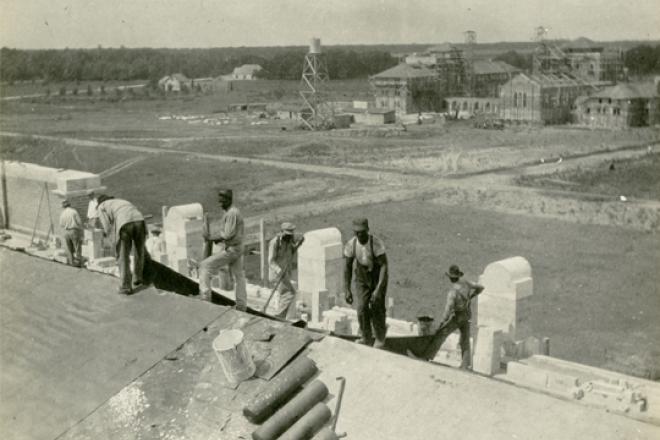Over the years, the University of Houston (UH) main campus has grown at a quick pace and has benefitted from an adaptive spirit. But it has also suffered consequences from that fast growth, with its sprawling parking lots, pastiche layout of buildings, overshadowed art pieces, and a general lack of cohesion between buildings. However, there are positives to mention as well. One major redeeming initiative is the university’s requirement that 1% of all new building construction funds go towards purchasing public art for the campus. This program is known as the Public Art of the University of Houston System (PAUHS) and has an equally dynamic board that steers an exciting vision of art commissions. With nearly 700 art pieces in its inventory, the PAUHS is celebrating its 50th anniversary year and is now a mature art collection that is ready for a thorough curatorial governance. While the PAUHS has community outreach programs, it also offers opportunities for interdisciplinary exchanges and public benchmarking. PAUHS Board member Judy Nyquist is a staunch believer that public art has a special quality of connecting a diverse cross section of Houstonians. She emphasizes that public art has the ability to be welcoming and that the art is able to democratize impromptu encounters. Dialogues are exchanged between citizens that come from all walks of life because every viewer is captivated by a public art piece. This is what Nyquist proclaims is the powerful impact public art offers: it provides a “concerted effort to equalize and not intimidate” communities that do not engage art on a daily basis. It’s this concern to facilitate and promote access to art for public enjoyment that makes Nyquist an ardent supporter and champion of the PAUHS.
The UH art collection is an impressive catalogue of diverse media, emerging and blue chip artists but, more importantly, it offers a unique commitment to provide art to its campus visitors and its surrounding community. A survey of the collection would provide a record of impressive acquisitions and commissions, but the collection has also been an unfortunate victim of the quick-pace growth of campus buildings and infrastructure. Maria C. Gaztambide, director and chief curator of PAUHS, now leads the effort of revisiting existing installations to determine how to improve their presence on the campus. Under her direction, Carlos Cruz-Diez’s “Double Physichromie” installation, which had languished for 15 years at a challenging location, was relocated to an improved site. The change resulted in a siting of the piece that is now fixed at a height that engages the viewer along the vantage point of their eyes. Go and visit this piece and enjoy the retinal illusions in full splendor as intended by Cruz-Diez, who was nothing short of a master of kinetic art. Walk around the “Double Physichromie” and become a “peripatetic zombie” as art critic Thomas Hess once proclaimed. Gaztambide has embraced her role of championing the needs of the public art pieces in the PAUHS collection by rethinking how each art piece engages the urban campus landscape, how each can provide an academic platform for the public and create new challenging dialogues within the campus and public communities.
The UH campus is currently under an exciting course of reshaping its urban landscape in coordination with the PAUHS where Gaztambide reminds us that it’s the best way and a “perfect time to revisit the collection.” In an effort to provide a sense of identity and place to different areas of the campus, the University has taken a page out of the contemporary urban planning playbook and designated a series of districts throughout the campus. These districts help to achieve a sense of order and association between buildings, paths, and lawns, by means of labeled maps and wayfinding markers. Each district is categorized in relation to the surrounding departmental buildings with future plans of thematically coordinating the public art within the PAUHS, in a likewise form, to all its satellite locations. UH is a top tier university and it is no less due to the innovative ethos of exploring the marriage between art and urban planning that is being adopted in its new campus development projects.
As UH continues to celebrate 50 years of PAUHS, one of the largest collections of art within a North American university system, it is hosting a series of artist talks, family programs and debuting a new temporary art installation. The newly formed UH Temporary Public Art Program (TPAP) chose to place their first commissioned piece in what is now the Arts District, within the courtyard of Wilhemina’s Grove. This very public space faces a large parking lot and is fronted on the remaining three sides by fine arts buildings. TPAP commissioned the internationally renowned artist Marta Chilindrón to create their first site specific art installation, Mobius Houston. This new piece by Chilindrón is a deliberate choice for its ability to create a disorienting sense of space, an ever-changing notion of a fixed point and collapse of form. These playful causalities are what Chilindrón captures best in her moebius constructs. Her smaller assemblies of circles, cubes, trapezoids, triangles and hexagons are pliable, dynamic and kinetic, while the piece installed at UH is static, inert and anchored, due to its scale and necessarily different program design. Chilindrón’s formal language is geometric and basic, but it thrives in the playful and accidental compositions of form.
This is where the contradictions of a simple shape, rigid material in a complex configuration became a challenge to construct at a large scale by design firm Metalab. The engineering of Mobius Houston had to calculate for Hurricane wind loads and account for stressors from the body weight of an intermittent child caught climbing the structure, which is a similar challenge found with the Jean Dubuffet sculpture at Discovery Green that was not designed to sustain climbers. Even with isolated challenges of use and external forces, the trickiest engineering task was to retain the clean edges at the gestural folds of acrylic so that they echo a frozen hinge. This jointed expression now evolved into a rib system that connects to a grade steel beam and concrete pier foundation in tripod form. The geometry permeates through the hidden structure and allows the acrylic panels to lightly strike the decomposed graveled court. But the unforeseen challenge in the whole composition was actually the catenary lights over the courtyard of the Chilindrón installation. These existing outdoor lights hang on a network of electrical cables strung across the courtyard at a height that challenged the construction of the foundation and placement of the acrylic panels, and the installation of these. Herein the existing lighting creates a snag and highlights how a previous design now has become a flaw that is ready for revision.
Chilindrón’s work consists, typically, of a small acrylic construct that the viewer’s hands can manipulate and whose form can be reconfigured, with every brandish of hand and finger articulation. In the context of her latest construct, Chilindrón replaces the viewer’s hands with their full body and their fingers with a pair of legs. Her jump in scale and the evolution of her geometric constructs now become a reverberant and amplified version of her smaller acrylic objects. They now, in fact, leap and invade the viewer’s context, creating an environment that saturates their perception with amalgams of shadow, light and color. The materiality of the large acrylic panels, in Mobius Houston, sculpts a cosmology of spaces predicated by its translucent nature. Chilindrón excitedly points to the large acrylic panels and reveals how “the sun will cast shadows” that she cannot foresee and most importantly how “the relationship between the refractive colors and qualities of space” will change as the viewer walks under the faceted structure. The phenomenon of distending opacities and the chromatic splendor created by the blazing Texas sunlight streaming through translucent colored acrylic will distinguish Chilindrón’s first outdoor mobius construct from her previous kinetic pieces.
This new temporary public art piece is an idealized frozen mobius form that will fool the eye and create perceptions of movement and elasticity. Unique spatial exchanges will emerge and “new color compositions will appear” as Chilindrón exclaims due to the fluid transitions of light, color, and shadow. UH and its campus locations are slated to undergo a chiral transformation such as Chilindrón’s mobius construct. The PAUHS has strategic plans to develop the percent for art with a renewed design of art integration, outreach and exchange upon the inauguration of the TPAP. In retrospect, the success of the percent for art program is that UH has an exemplary toolkit to rehabilitate and bridge its campus districts. The PAUHS and TPAP offer a great opportunity for UH to stimulate new public programs and develop an urban landscape that educates at every corner. Currently the campus is experiencing another rapid growth and the results of the PAUHS is palpable with the opening of its first temporary public art installation. “It will control you at first” exclaims Chilindrón about Mobius Houston, but a paradox will occur between the surrounding natural environment and those controlled edges and planes of acrylic. Go and see this latest temporary outdoor public art piece before it will be dismantled in six months! Activate your senses and walk through this acrylic portal of colors and shadows for a moment of chromatic magic.


